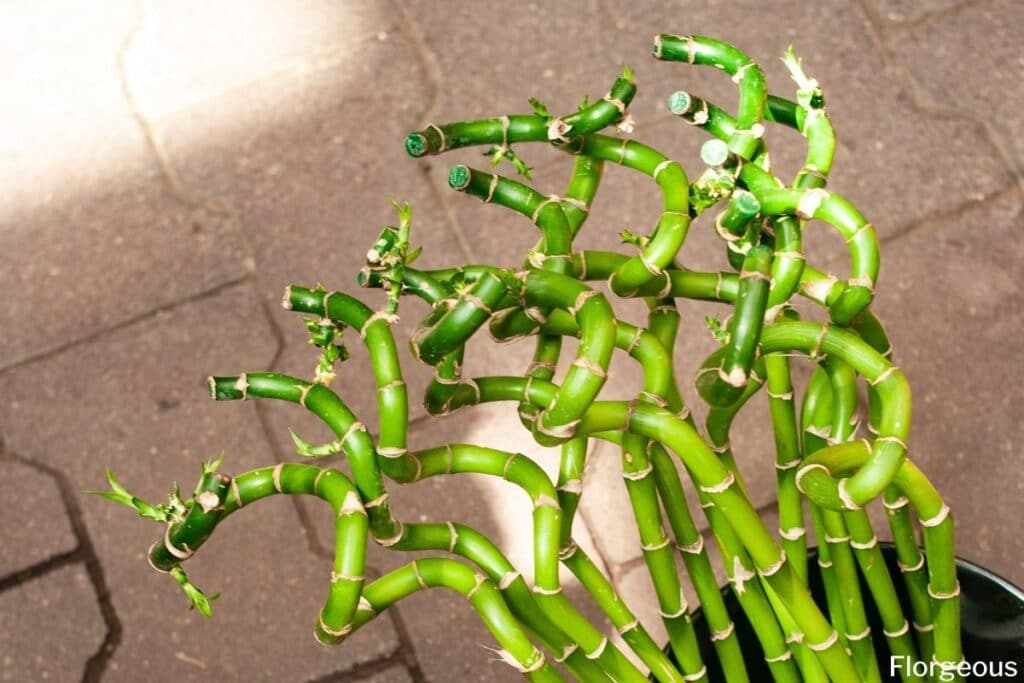Lucky bamboo (Dracaena sanderiana) is an excellent houseplant that is generally very hardy and easy to care for. Like all plants, they can suffer when given the wrong care, or affected by pests and diseases. This article covers the most common problems seen in these plants, and what you can do to restore them to perfect health.
The most common health problems we see in lucky bamboo plants show up as discoloration of the leaves, stems, and roots. This can range from only slight browning off the leaf tips, to leaves and stems that become completely yellow, and roots that turn black. Let’s take a look at what causes these issues.
Tap Water Troubles
Unfortunately, lucky bamboo plants are sensitive to chemicals that are found in tap water. Water suppliers usually treat the water to make it safe for human consumption and even to help keep our teeth clean! Chlorine, chloramine, and fluoride are common examples.
While these chemicals help to keep us safe, our lucky bamboo plants aren’t so lucky. Contact with these chemicals typically causes their leaf tips to turn brown.
To avoid these problems, only use water that is free from these chemicals. Good water sources for your lucky bamboo plants include:
- Reverse osmosis(RO) water
- Well water
- Rainwater
- Bottled water
- Distilled water
Poor Lighting
While lucky bamboo does make a great low-light house plant, that doesn’t mean it can survive without any light at all. Like all plants, they do need an appropriate light source to grow and stay healthy. If your plant is not getting enough light, it will grow slowly and become thin, weak, and pale.
On the flip side, lucky bamboo plants also don’t like too much light. Lucky bamboo prefers growing in the low light of the forest floor, where direct sunlight cannot reach. This means they should not be positioned in direct sunlight because it will cause the foliage to ‘burn’.
Low Humidity
As a tropical forest plant, your lucky bamboo is well adapted to very humid environments. Growing your plant in water usually provides plenty of humidity, but in very dry climates, browning of the leaf tips may still occur. If this is the case in your home, consider setting up a humidifier or misting the plant’s foliage.
Too Much Water
Overwatering is one of the biggest causes of houseplant problems. You may be wondering, how could you possibly overwater a plant that is grown in a vase of water? Well, this is usually more of a problem for lucky bamboo plants grown in soil.
Wet soil is the perfect environment for bacteria and fungi to grow, and these are what cause problems for your plants. Infections can lead to stem and root rot. Healthy roots should be orange and not black, while yellowing stems are a clear sign of trouble.
Plants that are grown in water only can still pick up some problems, however. The water should not be too deep, but rather just cover the roots. A depth of 2 inches (5cm) or so is usually sufficient, depending on the root development of your plant.
Plant Pests
While lucky bamboo plants tend to be pest-resistant, they are not immune to the attention of common plant pests like mealybugs and mites. The simplest way to manage infestations is to give the foliage a good rinsing with plain old water to wash off the offenders.
On more heavily infested plants, you may need to use neem oil or an insecticidal spray. Just make sure you follow the instructions carefully if using an insecticide.
Algae
Algae are plant-like organisms that also need light to grow. A clear vase full of water is the perfect environment for them to grow, especially if the container is exposed to plenty of light. Growing your lucky bamboo plant in an opaque container is the best way to avoid this issue.
If you prefer a clear container, changing the water at least once a week, and thoroughly cleaning the vase and gravel/pebbles at the same time will be necessary.
Airflow
Keeping your plant in an environment with no airflow can be very bad for its health. While a strong drought or very hot, cold, or dry airflow should be avoided, some natural air circulation is necessary for maintaining a healthy lucky bamboo plant.
Rotten Stems
Unfortunately, lucky bamboo turning yellow is dying and must be removed. If you are growing several lucky bamboo stalks together, close contact with a dying stalk can spread infection. Possible causes for this problem include over-fertilizing and fungal infections from overwatering.
After removing the dying stalk, wash off your other plants and change the water if you are growing them in a vase. Applying a fungicide or antibiotic may be helpful in serious cases.
FAQs
How do you revive a dying lucky bamboo plant?
To revive a dying lucky bamboo plant, first, assess the extent of the damage. If the roots are mushy or foul-smelling, trim away any affected parts and repot the plant in fresh, well-draining soil. Ensure the plant receives proper light, avoid overwatering, and trim away any dead or yellowing foliage. With proper care, the plant may recover over time.
What does an overwatered lucky bamboo look like?
An overwatered lucky bamboo may exhibit symptoms such as brown or yellow leaves, mushy or soft stems, and wilting or drooping foliage.
Conclusion
After reading this article, you should have a good idea of how to prevent problems with your lucky bamboo plant. If your plant is already in poor health, go through this list to determine the cause of the plant’s health problems. Luckily, this house plant is very resilient and there’s a very good chance that it will bounce back into great health.







